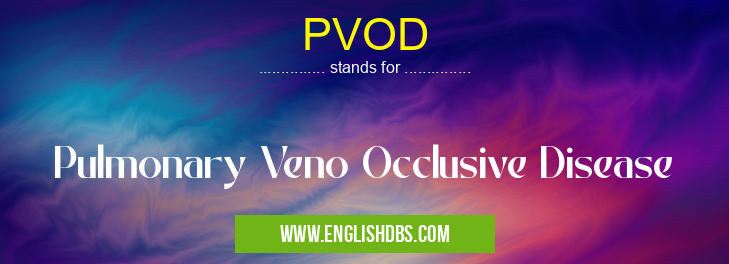What does PVOD mean in DISEASES
PVOD is an abbreviation for Pulmonary Veno Occlusive Disease which is a rare and serious disorder characterized by the narrowing or blockage of small blood vessels in the lungs, known as pulmonary venules. This condition restricts the flow of blood from the lungs back to the heart, leading to a buildup of pressure in the lungs.

PVOD meaning in Diseases in Medical
PVOD mostly used in an acronym Diseases in Category Medical that means Pulmonary Veno Occlusive Disease
Shorthand: PVOD,
Full Form: Pulmonary Veno Occlusive Disease
For more information of "Pulmonary Veno Occlusive Disease", see the section below.
Causes of PVOD
The exact cause of PVOD is not fully understood, but several factors have been associated with its development:
- Certain toxins and drugs: Exposure to certain toxins, such as pyrrolizidine alkaloids, and use of certain drugs like cocaine and anabolic steroids, have been linked to PVOD.
- Radiation therapy: Patients who receive radiation therapy to the chest area have an increased risk of developing PVOD.
- Sickle cell disease: People with sickle cell disease are more likely to experience pulmonary complications, including PVOD.
- Other medical conditions: Conditions such as heart failure, liver disease, or certain autoimmune disorders can increase the risk of PVOD.
Symptoms of PVOD
PVOD often develops gradually, and symptoms may vary depending on the severity of the disease. Common signs and symptoms include:
- Shortness of breath: Difficulty breathing, particularly during exertion.
- Fatigue: Feeling unusually tired or exhausted.
- Chest Pain: Pain or discomfort in the chest area.
- Wheezing: A whistling sound while breathing.
- Cough: A persistent or chronic cough.
- Swelling in the legs or abdomen: Fluid retention due to increased pressure in the lungs.
Diagnosis of PVOD
A diagnosis of PVOD is based on a combination of physical examination, medical history, and various tests, including:
- Chest x-ray: To check for signs of lung congestion and fluid buildup.
- Echocardiogram: An ultrasound of the heart to assess its function and any abnormalities in blood flow.
- Pulmonary function tests: To evaluate lung function and identify any limitations.
- Lung biopsy: In some cases, a biopsy of lung tissue may be necessary to confirm the diagnosis.
Treatment of PVOD
Treatment for PVOD focuses on managing symptoms and improving lung function. There is no cure for PVOD, but medications and lifestyle changes can help alleviate symptoms and slow the progression of the disease. Common treatments include:
- Diuretics: To reduce fluid buildup and ease shortness of breath.
- Oxygen therapy: To supplement oxygen levels in the blood.
- Pulmonary vasodilators: To widen the blood vessels in the lungs and improve blood flow.
- Lifestyle modifications: such as avoiding exposure to toxins, exercising regularly, and maintaining a healthy diet.
Essential Questions and Answers on Pulmonary Veno Occlusive Disease in "MEDICAL»DISEASES"
What is Pulmonary Veno Occlusive Disease (PVOD)?
PVOD is a rare condition that affects the small blood vessels in the lungs, known as pulmonary venules. These vessels carry blood from the lungs back to the heart. In PVOD, these venules become narrowed or blocked, leading to a buildup of pressure in the lungs and a reduction in blood flow to the heart.
What causes PVOD?
The exact cause of PVOD is unknown, but several risk factors have been identified, including:
- Certain medications, such as chemotherapy drugs and radiation therapy
- Bone marrow transplant
- Sickle cell disease
- Autoimmune disorders
What are the symptoms of PVOD?
Symptoms of PVOD can vary depending on the severity of the condition. Common symptoms include:
- Shortness of breath
- Fatigue
- Chest pain
- Cough
- Wheezing
- Swelling in the legs, ankles, and abdomen
How is PVOD diagnosed?
PVOD can be diagnosed through a combination of tests, including:
- Physical examination
- Chest X-ray
- Echocardiogram
- Pulmonary function tests
- Lung biopsy
What are the treatment options for PVOD?
Treatment for PVOD depends on the severity of the condition and the underlying cause. Options may include:
- Medications to improve blood flow and reduce pressure in the lungs
- Oxygen therapy
- Surgery to remove the blockages in the pulmonary vessels
- Lung transplant
What is the prognosis for PVOD?
The prognosis for PVOD varies depending on the severity of the condition. With early diagnosis and treatment, many people can live long and active lives. However, PVOD can be a serious condition and can lead to complications such as:
- Heart failure
- Pulmonary hypertension
- Stroke
- Death
Final Words: PVOD is a serious condition that can significantly impact lung function and quality of life. While there is no cure, early diagnosis and proper treatment can help manage symptoms and prevent further complications. If you experience persistent shortness of breath, chest pain, or other symptoms suggestive of PVOD, it is crucial to seek medical attention promptly for evaluation and appropriate treatment.
